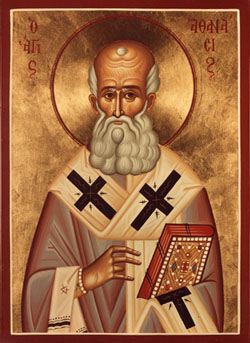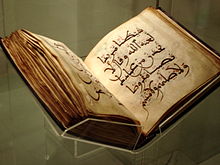Click here to return to 7) Imperial Decline and Seeds of Islam
Similarities / Divisions
The early military aspect of Islam could only be compared to later Christian Crusades. Conversely, the initial word, ministry of Christ, and the subsequent spread of the Gospels could only be deemed passive, with early Christian acceptance of martyrdom to further illustrate their passivity. By comparison, Muhammad and his earlier followers took up arms early on, but only after a peaceful attempt to relocate to Medina failed and armed persecutors pursued them.
There existed considerable division amongst Fourth Century Christians regarding scripture and the countless interpretations leading up to and after the Council of Nicaea (325 CE) when the canonical Gospels were establish. Rifts and subsequent new sects had developed (and continued long after Nicaea) as a result of late and often times disconnected transcriptions of the Gospels. By comparison, Islam eliminated the same type of scriptural division with very early transcriptions of the Quran. Subsequently, the content of the Quran remained unquestioned during and after the Shia-Sunni schism.
Islam would experience its own schism very early on when Ali ibn Abi Talib, who claimed to be the heir of Muhammad was overlooked during the creation of the Caliphate, a successive position of leadership required to continue the expansion of Islam. Ali would later gain control and become the fourth Caliph, to follow after assassinated Caliph Uthman ibn Affa. Ali himself would also be assassinated after reigning five years. A schism would then occur and Ali's followers, would separate to form the Shia sect. Today, Sunnis comprise the majority of Islam, with the Shias maintaining the smaller minority. Sectarian differences range from conflicting accounts regarding Islamic history and interpretations of scripture.
Conducive Events
Christianity’s growth throughout the Roman Empire was synonymous with the empire’s economic and military decline. Islam managed to take advantage of both the Roman and Persian empires' simultaneous military and economic decline, caused by years of war.
Likewise, Islam's spread was contingent on a vacuum created by the elimination of polytheistic pagan beliefs. Muhammad's armies would focus exclusively on the destruction of pagan (Persian Zoroastrianism and Roman/Greek Hellenistic Religion) temples and idols, which were inevitably tied to each government they conquered. Following the removal of pagan beliefs the government collapse would occur. Once conquered, Muslims attention would turn to improvements of infrastructure and the overall standard of living. Capitulation and economic dependence upon the muslim conquerers would then occurred naturally. Acceptance would be further accelerated by Muslim tolerance for monotheistic Christianity (regardless of sects) and Judaism.
By contrast, the Council of Nicaea probably created considerably more negative fallout than Constantine had imagined, as it lead to progressive division between Christian sects. Once Constantine had legalized Christianity and further empowered Church Bishops to prohibit non-Nicene worship, rifts began between council members and the various sects. This resulted in broad sectarian division which the Muslims were eventually able to capitalize on during their conquests.
By comparison, Muhammad expressed tolerance to all Abrahamic/monotheistic beliefs, regardless of canon. Subsequently, this became a major factor regarding the spread of Islam and the Muslim empire.
Umar reigned as the second Caliph of Islam for ten years (634 - 644 CE). Similar to Saint Paul, Umar began as a leading Meccan persecutor of the faithful. Once, while traveling to murder Muhammad, he stopped off at his sister's home where he was inspired with the faith after reading the Quran. Like Saint Paul, he would subsequently spread the faith further than any follower. However Umar would do so at the head of an army and not a monastic mission.
Commentary
The Sassanian Empire of Persia would finally be overrun and Byzantium would crumble after 700 year of war, but not by either’s sword. It would be Islam that would take advantage of the two empires which had already begun to collapse militarily and economically.
On a point of Christian faith, the post-Nicene edits forced further division amongst Christians which would continue beyond the first millennium. One particular group, the Gnostics, who’s beliefs regarding the divinity of Christ would be similar to (and predate) Islam, may have even been an early influence upon Muhammad. Of this last point we cannot be certain. However, in 1949 the discovery of the Gnostic Nag Hammadi Library would further testify to similarities, and these lost texts were located less than 250 miles southwest of where the Christian hermit Bahira made his revelations known about a 10 year old Muhammad, who would one day be known as "The Prophet".
Click here for 9) Pontifex Maximus and State Rule
Got Feedback?
Missions
 |
| Caliph on Horseback |
 |
| Early Christian Scripture |
Schisms
Both Christianity and Islam would experience major religious schisms. Latin Romans would split with the Eastern Orthodox Church during the great East-West Schism of 1054. This was the result of Latin/Greek cultural disparities as well as political divergence. Both factions would argue theological differences as well.Islam would experience its own schism very early on when Ali ibn Abi Talib, who claimed to be the heir of Muhammad was overlooked during the creation of the Caliphate, a successive position of leadership required to continue the expansion of Islam. Ali would later gain control and become the fourth Caliph, to follow after assassinated Caliph Uthman ibn Affa. Ali himself would also be assassinated after reigning five years. A schism would then occur and Ali's followers, would separate to form the Shia sect. Today, Sunnis comprise the majority of Islam, with the Shias maintaining the smaller minority. Sectarian differences range from conflicting accounts regarding Islamic history and interpretations of scripture.
Conducive Events
Economic Impact
 |
| Economic/Military Decline |
Polytheistic Vacuum
Also, during the spread of monotheistic Christianity, Pagan (Roman) polytheism remained closely associated to Rome's failing prestige and military standing. Gradually, over a few hundred years, the Christian population became formidable. Consequently, Emperor Constantine began to realize the value of uniting Christians within the government. He initially tied the two together with his apparent conversion at the Battle of Milvian Bridge and his subsequent legalization of Christianity with the Edict of Milan shortly thereafter. |
| Islam |
Tolerance
 |
| Athanasius of Alexandria |
By comparison, Muhammad expressed tolerance to all Abrahamic/monotheistic beliefs, regardless of canon. Subsequently, this became a major factor regarding the spread of Islam and the Muslim empire.
 Initiative
Initiative
Umar reigned as the second Caliph of Islam for ten years (634 - 644 CE). Similar to Saint Paul, Umar began as a leading Meccan persecutor of the faithful. Once, while traveling to murder Muhammad, he stopped off at his sister's home where he was inspired with the faith after reading the Quran. Like Saint Paul, he would subsequently spread the faith further than any follower. However Umar would do so at the head of an army and not a monastic mission.Commentary
The Sassanian Empire of Persia would finally be overrun and Byzantium would crumble after 700 year of war, but not by either’s sword. It would be Islam that would take advantage of the two empires which had already begun to collapse militarily and economically.
 |
| Nag Hammadi Library |
Click here for 9) Pontifex Maximus and State Rule
|
|
Got Feedback?
Comments? Questions? Corrections? Any feedback at all? Just click on the comments box at the bottom of this page and enter your thoughts. All comments are welcome.
Santuario de Guadalupe, the oil painting by Tom Mallon. This 42" x 22" canvas is the latest addition to the Santa Fe Portrait Series. The Santuario is the oldest shrine to Our Lady of Guadalupe in the US.
Visit this later update by CLICKING HERE
Shostakovich and Cultural Snobbery, Could anyone survive Stalin's Purges, compose a large body, write for himself and the masses while producing constantly great work?
Visit this later update by CLICKING HERE
Also of interest…
Tom Mallon's website "MallonArt". This website will provide you with links to all his paintings, drawings and other artwork portfolios, including the ongoing series entitled the Santa Fe Portrait.
Visit this later update by CLICKING HERE
Santuario de Guadalupe, the oil painting by Tom Mallon. This 42" x 22" canvas is the latest addition to the Santa Fe Portrait Series. The Santuario is the oldest shrine to Our Lady of Guadalupe in the US.
Visit this later update by CLICKING HERE
Shostakovich and Cultural Snobbery, Could anyone survive Stalin's Purges, compose a large body, write for himself and the masses while producing constantly great work?
Visit this later update by CLICKING HERE
Tom Mallon's website "MallonArt". This website will provide you with links to all his paintings, drawings and other artwork portfolios, including the ongoing series entitled the Santa Fe Portrait.
Visit this later update by CLICKING HERE





No comments:
Post a Comment